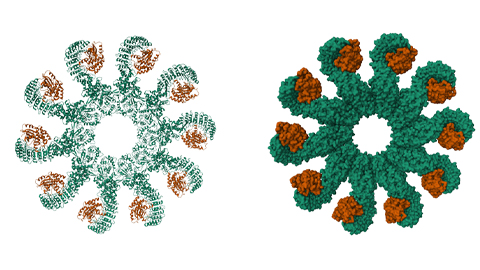New clues reveal how cells respond to stress
Inflammasome protein complexes form in response to signals associated with danger, such as an infection or environmental stress, and trigger the innate immune response. The serine protease dipeptidyl peptidase 9, or DPP9, forms a dimer in its active conformation and interacts with components of inflammasomes to prevent unnecessary activation. Scientists know that synthetic inhibitors of DPP9 activate certain inflammasomes. However, whether a cell-intrinsic molecule can inhibit this enzyme remains an open question. Therefore, Lydia Tsamouri, Jeffrey Hsiao and colleagues from the Weill Cornell Graduate School of Medical Sciences and Memorial Sloan Kettering Cancer Center investigated DPP9 interaction partners. They examined a connection between DPP9 and redox sensor KEAP1 in their recent Journal of Biological Chemistry article.

Using a fluorogenic probe that functions as a DPP9 substrate, the authors established that KEAP1 inhibits DPP9 activity in cells. They also found that KEAP1 can only inhibit DPP9 when both are introduced into cells at the same time via transfection with complementary DNA, or cDNA, that encodes each protein, before DPP9 dimerizes; newly introduced KEAP1 could not inhibit DPP9 already present in cells. The researchers hypothesized that KEAP1 interacts with DPP9 in a state different from its folded dimeric structure and that a cellular event or biomolecule could force DPP9 to adopt this alternative conformation. They tested multiple compounds, including electron transport chain inhibitors and oxidants like hydrogen peroxide, but they have not yet found a condition that leads to KEAP1–DPP9 complex formation and DPP9 inactivation.
Future experiments will focus on identifying a signal or molecules that could change DPP9’s conformation and whether the DPP9–KEAP1 interaction directly initiates inflammasome activation. Outlining the full DPP9 pathway involving inflammasomes will help scientists understand how cells convert danger signals into immune action and restrain unnecessary activation.
Enjoy reading ASBMB Today?
Become a member to receive the print edition four times a year and the digital edition monthly.
Learn moreGet the latest from ASBMB Today
Enter your email address, and we’ll send you a weekly email with recent articles, interviews and more.
Latest in Science
Science highlights or most popular articles

Mapping fentanyl’s cellular footprint
Using a new imaging method, researchers at State University of New York at Buffalo traced fentanyl’s effects inside brain immune cells, revealing how the drug alters lipid droplets, pointing to new paths for addiction diagnostics.

Designing life’s building blocks with AI
Tanja Kortemme, a professor at the University of California, San Francisco, will discuss her research using computational biology to engineer proteins at the 2026 ASBMB Annual Meeting.

Cholesterol as a novel biomarker for Fragile X syndrome
Researchers in Quebec identified lower levels of a brain cholesterol metabolite, 24-hydroxycholesterol, in patients with fragile X syndrome, a finding that could provide a simple blood-based biomarker for understanding and managing the condition.

How lipid metabolism shapes sperm development
Researchers at Hokkaido University identify the enzyme behind a key lipid in sperm development. The findings reveal how seminolipids shape sperm formation and may inform future diagnostics and treatments for male infertility.

Mass spec method captures proteins in native membranes
Yale scientists developed a mass spec protocol that keeps proteins in their native environment, detects intact protein complexes and tracks drug binding, offering a clearer view of membrane biology.

Laser-assisted cryoEM method preserves protein structure
University of Wisconsin–Madison researchers devised a method that prevents protein compaction during cryoEM prep, restoring natural structure for mass spec studies. The approach could expand high-resolution imaging to more complex protein systems.

